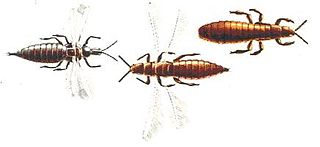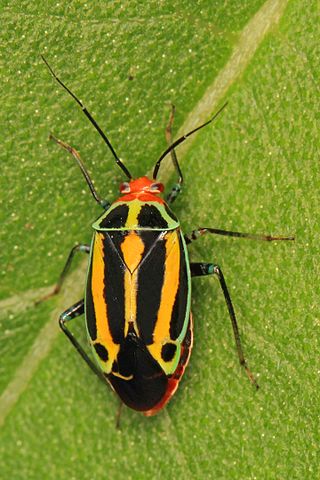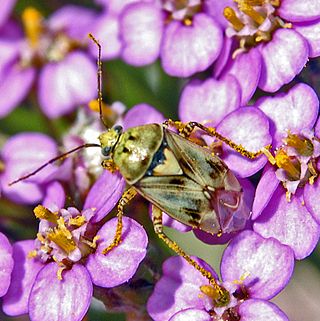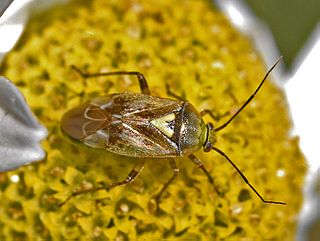
Hemiptera is an order of insects, commonly called true bugs, comprising over 80,000 species within groups such as the cicadas, aphids, planthoppers, leafhoppers, assassin bugs, bed bugs, and shield bugs. They range in size from 1 mm (0.04 in) to around 15 cm (6 in), and share a common arrangement of piercing-sucking mouthparts. The name "true bugs" is often limited to the suborder Heteroptera.

Thrips are minute, slender insects with fringed wings and unique asymmetrical mouthparts. Entomologists have described approximately 6,000 species. They fly only weakly and their feathery wings are unsuitable for conventional flight; instead, thrips exploit an unusual mechanism, clap and fling, to create lift using an unsteady circulation pattern with transient vortices near the wings.

The tarnished plant bug (TPB), Lygus lineolaris, is a species of plant-feeding insect in the family Miridae. It has piercing-sucking mouthparts and has become a serious pest on small fruits and vegetables in North America. It is considered a highly polyphagous species and feeds on over half of all commercially grown crop plants, but favors cotton, alfalfa, beans, stone fruits, and conifer seedlings. A study done in southwestern Quebec, Canada has investigated the presence of L. lineolaris in a commercial vineyard. This study also indicated that weeds that grow from cultivation of crops serve as an important food source for L. lineolaris. This insect can be found across North America, from northern Canada to southern Mexico. Adults grow up to 6.5 mm in length, and are brown with accents of yellow, orange or red, with a light-colored "V" on the back (dorsal). The genome has recently been sequenced for the first time.

Anthocoridae is a family of bugs, commonly called minute pirate bugs or flower bugs. Worldwide there are 500-600 species.

Bibionidae is a family of flies (Diptera) containing approximately 650–700 species worldwide. Adults are nectar feeders and emerge in numbers in spring. Because of the likelihood of adults flies being found in copula, they have earned colloquial names such as "love bugs" or "honeymoon flies".

Adelphocoris lineolatus, is commonly known as the Lucerne bug or the alfalfa plant bug, and belongs to the family Miridae. It is an agricultural pest causing vast amounts of damage to numerous crops, but primarily to alfalfa crops around the globe.

Rhabdomiris striatellus is a bug found widespread through the Europe with the exception of the extreme north and the southern Mediterranean.Its range extends east across Asia Minor to the Caucasus. It is common in the British Isles. The species is associated with oak trees. The body of the insect reaches 7–9 millimetres (0.3–0.4 in). The body is yellow to reddish brown and has yellow veins and dark stripes on its wings. The bug can also be much darker and similar to its relative, Miris striatus. The larvae suck flowers and fruits while the adults prey on aphids and the larvae of other insects.

Stenotus binotatus is a species of plant bug, originally from Europe, but now also established across North America and New Zealand. It is 6–7 mm (0.24–0.28 in) long, yellowish, with darker markings on the pronotum and forewings. It feeds on various grasses, and can be a pest of crops such as wheat.

Capsodes flavomarginatus is a species of plant bug belonging to the family Miridae, subfamily Mirinae.

Lygus pratensis is a species of plant bug belonging to the family Miridae.
Peristenus pseudopallipes is a parasitoid, which lives within a host as part of its life cycle. It then emerges from the host organism, killing the host.

Poecilocapsus lineatus, commonly known as the Fourlined Plant Bug, is a species of true bug (Hemiptera) in the family Miridae. This species is native to the United States and Canada.

Deraeocoris ruber is a species of bug in Miridae family.

Heterotoma planicornis is a species of bug from Miridae family.

The forest shield bug is a species of shield bugs endemic to New Zealand. Forest shield bug nymphs prefer feeding on grasses, while adults will eat a variety of New Zealand plants including "hard-leaved" plants like rimu. O. vittatus was one of the first insects from New Zealand to be described by a European scientist.

Myrmecoris gracilis is a species of flightless Hemipteran bug from the family Miridae. The genus Mymecoris is monotypic with one Palaearctic species. It differs in its outward appearance and way of life from other "grass bugs" in the Stenodemini, being predatory and an effective ant mimic.

Musgraveia sulciventris is a large stink bug found in Australia, sometimes known as the bronze orange bug. It is considered a pest, particularly to plants in the citrus group. Bronze orange bugs suck the sap from trees, which causes the flowers and fruit to fall.

Lygus gemellatus is a species of plant-feeding insects in the family Miridae.

Lygus rugulipennis, common name European tarnished plant bug, is a species of plant bugs of the family Miridae.

Plagiognathus arbustorum is a species of insects in the family Miridae, the plant bugs.



















